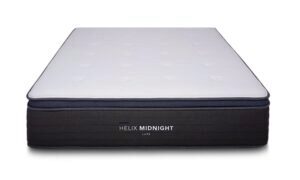What is Edge Support in a Mattress?
Disclosure: By clicking on the product links in this article, Mattress Nerd may receive a commission fee at no cost to you, the reader. Read full disclosure statement.
As you shop for a new mattress, you’ll want to consider a variety of factors such as firmness, material, durability, and size, but one other thing you should look at is the level of edge support, which is the amount of support you’ll find around the perimeter of your mattress. In this article, you’ll discover how mattress companies factor edge support into the construction of their items, and how edge support can have a significant impact on your sleep experience. You’ll also learn which mattresses provide good edge support so you can make an informed decision while shopping.
Edge Support, Explained
Before delving into the construction of a mattress’s edge support, it’s crucial that you understand what edge support actually is. In the mattress industry, edge support refers to the thick encasement around the edge of a mattress, which serves several purposes in order to ensure you have a proper sleep experience. A solid edge support system is necessary for the following reasons:
It prevents excessive sagging. Over time, the excess weight on your mattress will cause it to sag in certain spots and create an indentation of your body. If you sleep closer to the edge of the mattress, edge support will help avoid excessive sagging, allowing your mattress to retain its structural integrity.
It makes sitting on your bed easier. It’s common for people to sit on the edges of their mattresses while getting out of bed in the morning, doing stretches, putting on shoes, or for other reasons. Having good edge support will make it easier for you to sit down on the side of the mattress without worrying about sliding off.
It prevents falling out of bed. As mentioned previously, edge support keeps your mattress from sagging in spots around the edges. If your mattress sags too much by the edge, there’s an increased chance that you may actually fall out in the middle of the night. Edge support can act as a protective barrier to prevent you from sliding out, and combination sleepers who change their sleep positions frequently throughout the night need edge support to keep them on the mattress.
It provides a larger sleeping surface. If you share a bed with someone, especially if it’s a queen-size mattress or smaller, you may notice that the sleep surface can be a little too narrow for your liking. Luckily, edge support creates extra sleep space for you and your partner so you don’t need to worry about having enough room.
It can prevent muscle and joint pains and aches. Getting in and out of bed can put a heavy strain on your back and knees. If you have a mattress with poor edge support, you’ll endure more muscle soreness and back pain because your body needs to work harder to help you get out of bed. Strong edge support is necessary to promote better muscle and joint health.
It reduces motion transfer. Good edge support can assist with reducing motion transfer, which is when movement travels across the bed. If you share your bed with a partner, high edge support offers excellent motion isolation, meaning that you’re less likely to wake up the other person if you decide to get out of bed at night.
How is Edge Support Constructed?
Although mattresses can come in a wide variety of materials, such as latex, wool, memory foam, polyfoam, or innerspring, edge support typically involves three primary materials:
Heavy gauge metal coils: The coils you’ll find in edge support are different than the kind that are located within the rest of the mattress. Mattress brands use heavier, thicker coils for the edges to deliver extra support and to withstand more wear and tear without losing their integrity. This is why, when you sit on the edge of the bed, you’ll find it to be much firmer than if you were to sit in the middle.
Steel rods: Steel rods are commonly found in more inexpensive mattresses because they are an economical option. They supply excellent edge support that’s almost comparable to coils, except steel rods aren’t as durable. In fact, if you put too much weight on the rods, they can bend and lose most of their edge support capabilities.
Foam encasement: Out of all the materials used in edge support, polyurethane foam may be one of the best. It is durable and firm enough to withstand excessive weight for long periods of time, and it’s still sturdy and comfy enough to sleep on. If you’re someone who tends to sleep closer to the edge, you’ll find little difference in the quality of the sleep surface when foam encasements are used.
Who is Edge Support Important For?
It’s always a good idea to find a mattress with proper edge support; however, there are some demographics that may benefit from it the most.
Sleeping Position
Everyone falls under one of several sleeping position categories: side, stomach, back, or combination. Side sleepers typically look for mattresses that are softer since they offer better cushioning and support for their shoulders and hips, which means edge support isn’t as important for them. Back and stomach sleepers, though, require a medium-firm to firm mattress surface to encourage adequate spinal alignment, so they will gravitate toward firmer mattress options with a higher level of edge support.
Age
The older you get, the more difficult it can be to get out of bed. You want to ease the stress on your muscles and joints while getting out of bed, so you should choose a mattress that has a high level of edge support and won’t sag over time.
Weight
In line with the same principles as age, someone’s weight can also factor into the importance of edge support. Heavier people will put more stress on the edges of their mattresses as they get in and out of bed. A mattress with proper edge support won’t lose its structure or shape as easily from this activity.
Personal Preference
It’s important that you keep personal preference in mind while you shop for mattresses. For instance, do you prefer to watch television while sitting on the edge of the bed? If so, then you’ll want to put edge support as one of your top priorities during the mattress purchase. You just need to remember that higher edge support usually means less pressure-relieving properties.
Which Mattresses Have the Best Edge Support?
Mattresses come in a variety of compositions, and thus have their own level of edge support that they provide. Out of all these options available, which types of mattresses have the best edge support?
Foam Mattresses
All-foam mattresses are known for contouring to your body’s unique shape and curves so that they don’t aggravate pressure points. Because of its shape-retaining qualities, memory foam doesn’t require a high level of edge support as it will do a good job of avoiding sagging on its own.
Latex Mattresses
Latex mattresses, like memory foam mattresses, contour to your body’s shape and deliver pressure relief, but they offer much more bounce and firmness. These qualities allow latex mattresses to perform well even without reinforced edges.
Hybrid Mattresses/Innerspring Mattresses
Hybrid and innerspring mattresses include metal coils throughout their construction, and hybrid mattresses have a comfort layer of memory foam or latex on top of them. These mattresses will often have an extra layer of sturdy, reinforced springs around their edges, making them the best mattresses for edge support.
Conclusion
Shopping for a new, high-quality mattress can be a fun experience, but you still need to consider the fact that you’ll be spending approximately a third of your life in bed, which means that you need to pick a properly-built mattress that can adequately support you. Spend some time carefully evaluating a mattress’s edge support so that you can pick the right mattress that will give you a good night’s sleep.


